Manuscript accepted on : 21-08-2023
Published online on: 26-09-2023
Plagiarism Check: Yes
Reviewed by: Dr. Ichrak Jaouadi
Second Review by: Dr. R. Arthe
Final Approval by: Dr. Ghulam Md Ashraf
Research Institute of Vegetable Growing, Public legal entity, Baku, Azerbaijan.
Corresponding Author E-mail:eyvazov.aladdin@mail.ru
DOI : http://dx.doi.org/10.13005/bbra/3148
ABSTRACT: The article presents the findings of a biomorphological evaluation conducted between 2016 and 2018, focusing on 105 eggplant collection samples sourced from different geographical origins on the Absheron Peninsula in the Republic of Azerbaijan. Additionally, 59 of these samples underwent evaluation based on physiological indicators. The research categorized the eggplant samples into three groups based on their ripening time: mid- season (81-100 days) - 24.9%, mid-late-season (101-120 days) - 56.2%, and late-season (121-148 days) - 21.9%. Specific eggplant varieties were identified for each group. Group I (81-90 days) included representatives 140/A, 69/B, 141, 142, 152, and 162, while Group II (101-102 days) comprised samples 137, 140/B, 149/A, 149, 149-199, 213, 232, 239, 242, and 243. Group III (121-124 days) consisted of varieties exhibiting late-ripening characteristics. Some varieties within the collection showed variations in leaf area, photosynthetic potential, chlorophyll content in leaves, absolute leaf surface density, total wet and dry biomass. These characteristics make them valuable primary candidates for future breeding efforts, targeting enhanced productivity and adaptability. The study also suggested an optimal model for photosynthetic indicators to achieve high eggplant yields (ranging from 290 to 800 q/ha).
KEYWORDS: Eggplant; Optimal Model; Photosynthetic İndicators; Ripeness; Varieties
Download this article as:| Copy the following to cite this article: Eyvazov A. G. Evaluating Eggplant Collection Samples and Selecting Primary Donors Based on Physiological Indicators. Biosci Biotech Res Asia 2023;20(3). |
| Copy the following to cite this URL: Eyvazov A. G. Evaluating Eggplant Collection Samples and Selecting Primary Donors Based on Physiological Indicators. Biosci Biotech Res Asia 2023;20(3). Available from: https://bit.ly/3rrhJqP |
Introduction
The Scientific Research Institute of Nutrition recommends a yearly eggplant consumption of 2-5 kg per person for normal life activity. However, our calculations indicate that this amount should be at least 5-8 kg annually. When considering various canned eggplant products, such as salted, vinegared, and caviar forms, the recommended intake should be at least 9-12 kg per year. Factoring in the projected population of the republic in 2024-2025, which will exceed 11 million people, the estimated demand for eggplant production is 99-132 thousand tons. Regrettably, the current average eggplant production in Azerbaijan stands at only 86,519.73 tons1.
The calorie content of eggplant fruits is approximately 25-30 KC. Eggplants contain protein in the range of 0.8-2.24 g, fat ranging from 0.2-0.52 g, carbohydrates between 7.1-8.7 g, and ash elements at 0.87 g2. Additionally, eggplant is a good source of various vitamins, including vitamin A, vitamin E, vitamin K, and vitamin C (ranging from 2 mcg to 43 mg), as well as vitamins B1, B2, B3, B4, B5, B6, and B9 (ranging from 14 mcg to 9.4 mg)3. Moreover, eggplant is rich in several macro- and microelements that are beneficial for the human body: Ca (6.0 mg / 100 g), Fe (0.3 mg), Mg (11 mg), F (15.0 mg), K (123 mg), Na (40.0 mg), Zn (0.1 mg), Cu (0.1 mg), Mn (0.1 mg), Se (0.5 µg), U (0.2 µg ), St(15 mg), Ge (47 mg/100 g)4.
Several research studies have investigated the factors that impact the ideal growth and development of eggplant varieties and hybrids. These works have clarified both the positive and negative effects of environmental factors on eggplant development and have put forth suggestions for optimization. While the influence of plant structure, leaf surface, and certain photosynthetic parameters on eggplant productivity has been examined for high-yielding varieties in various studies, an optimal model for these factors has not been proposed yet 5, 6, 7, 8, 9.
The aim of this study is to assess the eggplant collection samples based on photosynthetic indicators and productivity, with the objective of identifying the optimal criteria for developing a high-yielding variety model.
Material and Methods
The material for this study consisted of samples obtained in 2016-2017 from various sources, including the gene foundation of the Scientific Research Institute of Vegetable Growing, All-Russian Research Institute of Vegetable Breeding and Seed Production (VNIISSOK), Institute of Genetic Resources of the Ministry of Science and Education of the Republic of Azerbaijan, and the World Vegetable Center.
The leaf surface area of eggplant varieties was measured using a portable device called LI-3000 C, while the chlorophyll content in the leaves was assessed using a Chlorophyllmeter SPAD-502 by comparing the results with the device’s attached table. To determine the amount of dry biomass and dry matter, the method described by A.I. Ermakov was employed10, and the raw biomass was measured by weighing on a chemical-technical balance.
The photosynthetic potential (PP) was calculated by multiplying the leaf surface area (Lor) measured during the vegetation period by the number of days the vegetation lasted (Tv).
PP= Lor x Tv11,12
The absolute leaf surface density (ALSD) refers to the dry leaf mass per unit area of the leaf surface, expressed in mg/cm2,12.
The research findings underwent statistical analysis, and correlations between various indicators were established13,14. A total of 105 collection samples, situated in the source material nursery, were examined, with physiological studies conducted on 59 of them. The samples were planted using the seedling method in a scheme of 70×25 cm. The results were compared with regionalized varieties Zahra and Gyanja in Azerbaijan. Following planting, essential agrotechnical measures such as irrigation, fertilization, mulching, and dredging were implemented, and phenological observations were recorded. Physiological studies on the eggplant collection samples were conducted during the period of mass flowering and the initiation of fruit formation.
Results and Dıscussıon
Based on the phenological observations, the studied collection of samples can be categorized into three groups based on their maturity, from the time of planting seedlings to the technical ripeness of fruits: mid-season, mid-late-season, and late-season. Group I, comprising 23 samples (21.9% of the total), had a maturity period of 81-100 days. Examples of this group, maturing in 81-90 days, include 140/A, 69/B, 141, 142, 152, and 162. Group II, the largest with 59 samples (56.2% of the total), took 101-120 days to mature. Examples within this group, maturing in 101-102 days, are 137, 140/B, 149/A, 149/B, 149, and 150. Group III, also consisting of 23 samples (21.9% of the total), required the longest time to mature, 121-148 days. Typical examples of this group, maturing in 121-124 days, include 199, 213, 232, 239, 242, and 243 (Figure 1).
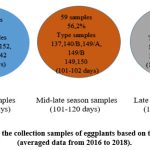 |
Figure 1. Organizing the collection samples of eggplants based on their level of ripening (averaged data from 2016 to 2018). |
Consequently, the research revealed that the majority of the studied samples (59 samples or 56.2%) belonged to the mid-late-season group, similar to the regionalized Zahra variety. Among the samples, 140/A proved to be the earliest maturing variety, taking 81 days, while 216 was the latest, maturing in 148 days.
A statistical analysis of the 2-year (2016-2017) and 3-year average productivity indicators of the studied collection samples was conducted, leading to the determination of an average mathematical value of 406.78±13.20 c/ha. The coefficient of variation was found to be 24.92%, and the SID05 amounted to 37.77 c/ha. Based on the statistical analysis, it was observed that 32 collection samples (30.48%) demonstrated higher values in terms of average productivity, ranging from 460-880 c/ha, exceeding 444.55 c/ha/ha during the research years, with a 95% level of probability. Conversely, 55 samples (52.38%) showed lower values with an average productivity range of 200-360 c/ha. The average yield of the remaining 18 samples (ranging from 369.0 to 453.0 c/ha) could not be considered reliable since neither the upper nor lower values fell within the interval of the 95% probability level (Fig. 2). The typical representatives of high-yielding varieties (168, 140/A, 206, 179/A, and 254) exhibited yields ranging from 547-880 g/ha.
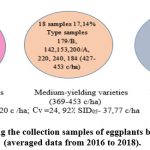 |
Figure 2. Organizing the collection samples of eggplants based on their yield (averaged data from 2016 to 2018). |
Based on the conducted research, it can be concluded that certain variety samples of different geographical origins, introduced from foreign countries, have successfully adapted to local conditions and demonstrated advantages in terms of both biomorphological and value-economic characteristics. These variety samples can be regionally classified in the country and utilized effectively in further breeding programs aimed at enhancing productivity.
The growth processes and accumulation of dry matter, as well as other beneficial compounds such as sugars, ascorbic acid, proteins, and amino acids, are closely linked to photosynthesis, which is an essential physiological property of plants15,16,17,18.
Throughout the years of research, 59 eggplant collection samples were evaluated based on parameters including leaf surface area, photosynthetic potential (PP), absolute leaf surface density (ALSD ), total wet and dry biomass, leading to the proposal of an optimal physiological parameter model for high-yielding varieties. Statistical analysis of the evaluated indicators indicates that the average leaf surface area for the collection samples was 4.48 ± 0.48 thousand m2/ha, with a coefficient of variation of 76.10% and an SID05 of 1.31 thousand m2/ha or 26.84%. Consequently, due to the high coefficient of variation, it becomes possible to select samples (ranging from 12.6 to 18.1 thousand m2/ha) that significantly differ in terms of leaf surface area with a 95% probability. Notable examples of these samples include 181 (12.6), 223 (12.7), 226 (13.1), 189 (13.3), 140/B (13.4), 180 (13.7), 167 (16.8), and 222 (18.1 thousand m2/ha) (Fig. 3).
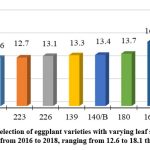 |
Figure 3: A selection of eggplant varieties with varying leaf surface areas (averaged data from 2016 to 2018, ranging from 12.6 to 18.1 thousand m2/ha).
|
SID 05 = 1, 31 с/ha
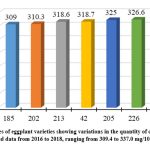 |
Figure 4: Samples of eggplant varieties showing variations in the quantity of chlorophyll in the leaves (averaged data from 2016 to 2018, ranging from 309.4 to 337.0 mg/100 fresh weight).
|
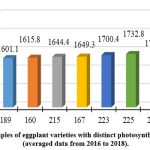 |
Figure 5: Samples of eggplant varieties with distinct photosynthetic potentials (averaged data from 2016 to 2018).
|
1601, 1- 2511, 3 thousand m2.day/ha
SID05 = 159, 01 thousand m2.day/ha
As depicted in Figure 5, all other samples, with the exception of 181 and 180, exhibit elevated values of photosynthetic potential (ranging from 1601.1 to 2511.3 m2 day/ha).
It is well-established that the amount of chlorophyll present in the leaves provides insights into the efficiency and productivity of a plant’s photosynthetic apparatus14,19,20. Through the research conducted, it was determined that the average amount of chlorophyll in the leaves (mg/100 g of wet weight) among the eggplant collection samples is 249.47±6.97, with a coefficient of variation of 21.45% and SID05 of 19.99 mg/100 g or 8.0%. While this characteristic shows less variability compared to leaf area and plant photosynthetic potential (PP), it still allows for a sufficient number of initial donors to be selected based on the amount of chlorophyll in the leaves. Figure 4 displays samples with high chlorophyll content, ranging from 309.4 to 332.0 mg/100 g ww.
Assessing the collection accessions based on the ALSD value, which serves as a crucial indicator of a plant’s adaptability to environmental factors, can prove to be a valuable “test” indicator in breeding, addressing both adaptability and productivity11,12,21,22,23. The average value of ALSD (absolute leaf surface density) was calculated to be 6.53±0.22 mg/ cm2, with a coefficient of variation of 25.49%, and an SID05 of 0.31 mg/cm2, corresponding to 4.75%. Figure 7 displays the collection samples exhibiting high ALSD values at a 95% probability level, making them potential valuable donors in the selection of drought-resistant and heat-resistant varieties for further breeding purposes.
Monitoring the changes in total wet and dry biomass of plants, considered a crucial indicator of photosynthetic activity, across collection samples revealed that the average total wet biomass is 119.64±5.08 c/ha, with a coefficient of variation of 37.09%, and SID05 of 16.88 c/ha or 14.11%. As for total dry biomass, the corresponding values were 21.38±0.74, 26.59, and 2.11, or 9.90% respectively. Samples 140/A, 140/B, 164, 167, 207, and 226 were singled out for exhibiting these characteristics (Figures 6 and 7). These samples hold potential for effective use in breeding programs aimed at enhancing both productivity and adaptability.
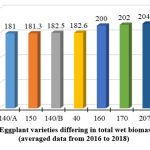 |
Figure 6: Eggplant varieties differing in total wet biomass content (averaged data from 2016 to 2018)
|
181, 0- 212, 6c/ha
SID05 = 16,88 c/ha
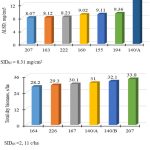 |
Figure 7: Eggplant collection samples that vary in ALSD value and total dry biomass value (averaged data from 2017 to 2018)
|
The research resulted in the identification of an optimal model for photosynthetic indicators to achieve different eggplant yields (ranging from 290 to 800 g/ha) from various varieties. These indicators can be attained by properly adhering to agrotechnical guidelines. The study demonstrates that, in order to obtain 700-800 c/ha of eggplants on the Absheron Peninsula, the recommended leaf surface area should be within 15-18.5 thousand m2/ha, the crop’s photosynthetic potential (PP) should be at least 1800 thousand m2 day/ha, the absolute leaf surface density (ALSD ) should exceed 9.02 mg/cm2, the amount of chlorophyll in the leaves should be at least 331 mg/100 g wet weight, and the total wet and dry biomass should be more than 200 and 28.3 c/m2 ha, respectively (see table).
Table 1: Model of optimal photosynthesis parameters for obtaining high yields of eggplant varieties
|
Yield, c/ha |
Leaf surface area, thousand m2 day/ha |
Photosynthetic potential, min m2 day/ha |
Absolute leaf surface density, mg/cm2 |
Amount of chlorophyll in leaves, mg/100g Fresh weight |
Total fresh biomass, c/ha |
Total dry biomass, c/ha |
|
290-400 |
6,7-11,1 |
829-1146 |
5,83-6,35 |
183-213 |
115-135 |
18-23 |
|
401-500 |
11,2-12,2 |
1200-1370 |
6,40-7,50 |
215-263 |
136-157 |
23,1-25,0 |
|
501-600 |
12,4-13,4 |
1400-1600 |
7,51-8,12 |
270-310 |
160-180 |
25,1-27,0 |
|
601-700 |
13,4-14,8 |
1600-1800 |
8,23-9,02 |
310-330 |
181-200 |
27,1-28,2 |
|
701-800 |
15-18,5 |
More than 1800
|
More than 9,02 |
More than 331
|
More than 200 |
More than 28,3 |
Conclusıon
Based on the biomorphological evaluation of 105 eggplant collection samples and physiological indicators of 59 samples conducted on the Absheron Peninsula of the Republic of Azerbaijan from 2016 to 2018, the following conclusions can be drawn:
The eggplant collection samples are categorized into three groups based on their ripening period: Group I (21.9%) represents mid-season varieties with a ripening period of 81-100 days, Group II (56.2%) includes mid-late-season varieties with a ripening period of 101-120 days, and Group III (21.9%) comprises late-season varieties with a ripening period of 121-148 days. The typical examples for Group I (81-90 days) are 140/A, 69/B, 141, 142, 152, and 162, for Group II (101-102 days) are 137, 140/B, 149/A, 149/B, 149, and 150, and for Group III (121-124 days) are 199, 213, 232, 239, 242, and 243.
Selected among the varietal samples are those exhibiting variations in leaf surface area, photosynthetic potential of plants, chlorophyll content in leaves, specific surface density of leaves, total wet and dry biomass. These samples are highly recommended as valuable primary donors for future selection processes, with a focus on enhancing productivity and adaptability.
A recommended model of photosynthetic parameters is proposed to achieve a high yield from eggplant plants, ranging from 290 to 800 q/ha.
Acknowledgement
I express appreciation to the Scientific Research Institute of Vegetable Growing for its support of this research.
Conflict of Interest
I have declared that no conflict of interest exists.
Funding source
There is no funding for this article
References
- Eyvazov A.G., Aghayev F.N., Abdullayeva Kh.T, et al. Breeding, physiology and seed production of eggplants – Baku: “ Tereggi” MMC, -2018, -167 p. (in Azerbaijani)
- Verba V.М. Development of elements of technology aimed at expanding the genetic diversity of eggplant when breeding for quality: / uch. Art. cand. s.-x. Sciences / – Moscow, 2011, -126 p. (In Russian).
- Achikanu C.E., Eze-steven P.E., Ude C,M etal. Determination of vitamin and mineral composition of common leafy vegetables in southern Nigeria // International Journal of current microbiology and Applied Science, – Tamil Nau:-2013. –V.2. -pp.347-353
- Eggplant – chemical composition, nutritional value, –BJU: Fit Audit. – 2022. url:https:/fitoudit.ru (In Russian)
- Golubkina N.A., Sirota S.M., Pivovarov V.F. et al. Biologically active compounds of vegetables. – M.: VNIISSOK, 2010. – 200 p. (In Russian)
- Knyazeva D., Knyazeva T. Secrets of super-harvest: tomato, pepper, eggplant, potatoes. – Moscow: Eksmo, -2011, – 284 p. (In Russian)
- Korol V.G. Harvest under the film: the prospects for the development of vegetable growth in film greenhouses. Moscow: Gavrish, -2015, – No. 3. – p.26-31 (In Russian).
- Litvinov S.S. Scientific foundations of modern vegetable growth. Moscow: RAAS., -2008,-771 p. (In Russian).
- Magomedova D.S., Kurbanov S.A., Shabanova M.Sh. Complex effect of fertilizers and drip irrigation on the yield of eggplant // Moscow: Vegetables of Russia, -2021. №2. p.67-70. (In Russian).
CrossRef - Methods of biochemical research of plants (under the editorship of A.I. Ermakov) – Leningrad: Agropromizdat, Leningrad branch. – 1987, – 430 p. (In Russian).
- Eyvazov A.G., Aghayev F.N. Abbasov R.Ə. Potato physiology, cultivation by intensive technology and methods for obtaining a programmed yield –Baku, “ Tereggi” MMC,-2017, -212 p. (in Azerbaijani).
- Yusifov M.A. Physiology of watermelon. – Baku: NUR-A, – 2004, -216 p. (in Azerbaijani).
- Litvinov S.S. Methods of field experience in vegetable growth. – Moscow: Russian Agricultural Academy, -2011,-648 p. (In Russian).
- Ryazanova L.G.,Provorchenko, A.V., Gorbunov I.V.Fundamentals of statistical analysis of research results in gardening: educational – methodological manual. – Krasnodar: KubGAU, 2013. – 61 p. (In Russian).
- Mamedov M.I., Pyshnaya O.N., Jos E.A., et al. Eggplant (Solanum sp.). – Moscow: VNIISSOK, -2015, -264p (In Russian).
- Mokronosov A.T., Gavrilenko V.F., Zhigalova T.V. Physiological-ecological and biochemical aspects of photosynthesis. Moscow: Academy, -2006,-320p.
- Suprunova T.P., Shumilina D.V., Pyshnaya O.N., Mamedov M.I. Genetics and selection of eggplant pepper // Proceedings of Conf. “XV Meeting on Genetics and Breeding of Capsicum and Eggplant” Eucarpia, Italy.-Torino:-2-4.09.2012.-2013.-p. 200-205. (In Russian).
- Timina О.А., Breeding and genetic characteristics of the source material of Capsicum L. according to the main economically valuable traits. Abstract of the dissertation for the degree of Doctor of Biological Sciences, / Moscow, -2012, -47p (In Russian).
- Tayleb М. Combining ability of inbred eggplant lines according to valuable economic traits: / Abstract of diss. uch. Art. cand. s.-x. Sciences-Moscow, -2011.-20 p. (In Russian).
- Tosunov Ya.K., Barchukova A.Ya. Efficacy of Chunky preparation on sweet pepper and eggplant. Krasnodar scientific journal Kub, GAU, – 2014, – No. 7 (101). p. 1-10. (In Russian).
- Aghaev F.N., Abbasov R.A., Askerov A.T. Variability of photosynthetic parameters in potato varieties in ontogeny depending on plant density // Proceedings of the VI International Scientific and Practical Conference (within the framework of the V Scientific Forum “Week of Science in Kruty -2020”) (March 10-11, 2020), Ukraine, Chernihiv both.: – Cool, -2020, vol.1. -p. 12-22. (In Russian).
- Rasulov B.Kh., Asrorov K.A. Dependence of the intensity of photosynthesis of various types of cotton on the specific surface density of the leaf. / Moscow: Science. In: Physiology of Photosynthesis, 1982. -p.270-283. (In Russian).
- Plich, J., Boguszewska-Mańkowska, D. & Marczewski, W. Relations Between Photosynthetic Parameters and Drought-Induced Tuber Yield Decrease in Katahdin-Derived Potato Cultivars. Potato Res., 2020, v.3, p,463–477/
CrossRef

This work is licensed under a Creative Commons Attribution 4.0 International License.





